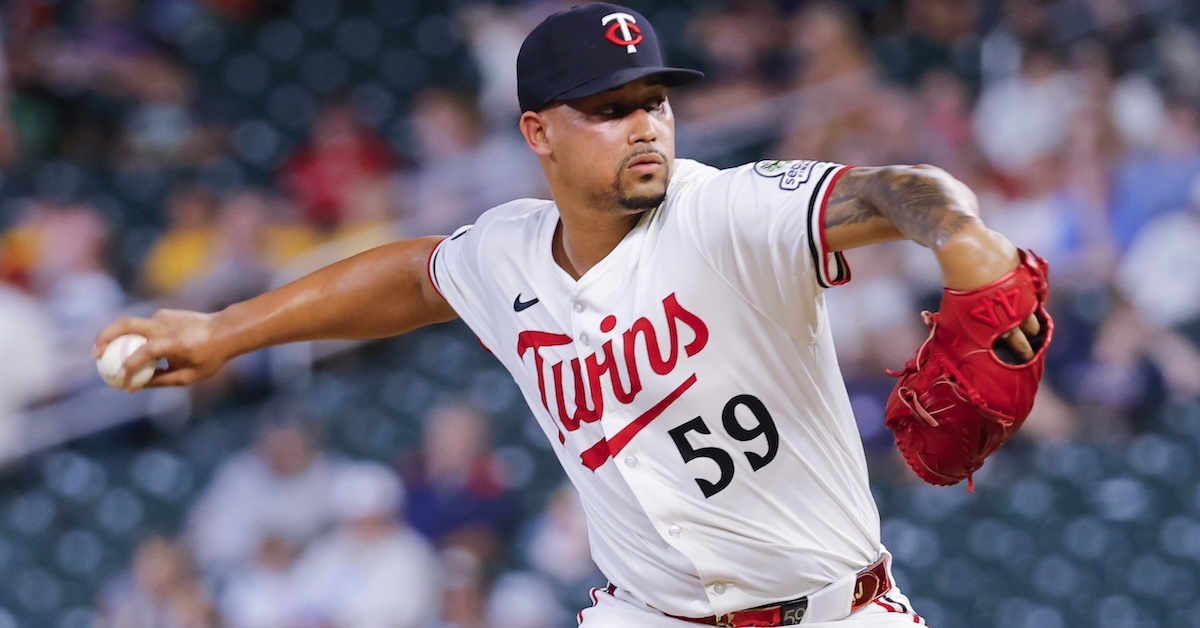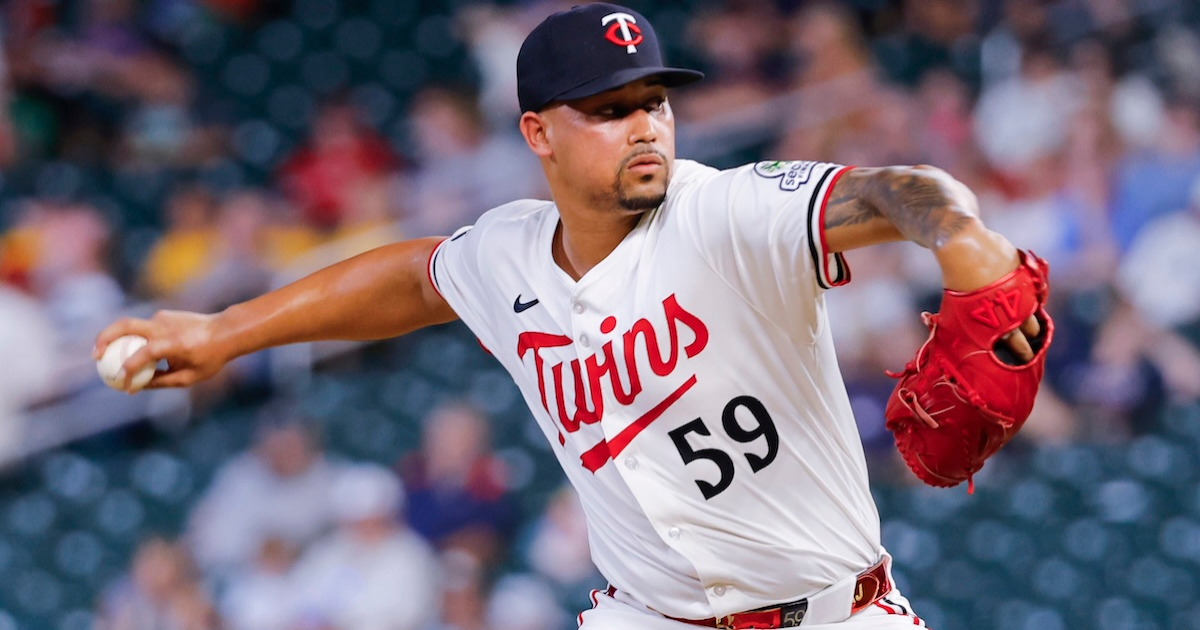
The Philadelphia Phillies needed to get a reliever at the deadline, and they’ve got a doozy. Jhoan Duran, the 27-year-old flamethrower late of the Minnesota Twins, is taking his splinker east. This is a seller’s market for relievers, and Duran is the best one available; certainly the best with any kind of long-term team control remaining, and even more so now that Emmanuel Clase is indisposed.
Given Duran’s prodigious gifts, track record of durability and reliability, and two full remaining arbitration years, the cost is high: rookie right-hander Mick Abel and teenage catcher Eduardo Tait. Abel, the first high school pitcher taken in the 2020 draft, had an unsteady progression through the minors, but has shown flashes in limited major league action. Tait, fresh off a futures game invite, is an 18-year-old catcher and therefore quite raw, but he has the tools to be a good defender with plus, even plus-plus power at the plate.
It’s not Andrew Painter, or even Aidan Miller, but it’s a lot of freight from a not-that-great farm system, in order to get a one-inning reliever. Why would the Phillies do this? Well, not to be impolite, but they’re kind of desperate.
In 2023 and 2024, the Phillies had top-five bullpens in the regular season, then watched their championship hopes vanish when their high-leverage guys humped the bunk. Every time I think about what happened to Craig Kimbrel (and to a lesser extent Orion Kerkering) in Game 4 of the 2023 NLCS, my cardiologist gets mad at me, so if you want more details you can find them on YouTube or something.
Blame for last year’s NLCS exit to the Mets is almost universal; apart from Zack Wheeler, Nick Castellanos, and Bryce Harper, none of last year’s Phillies were free from sin. But I will mention this: In that NLDS, four high-leverage Phillies relievers (Kerkering, Matt Strahm, Jeff Hoffman, and Carlos Estévez) combined for a championship WPA of minus-14.85. For context, Corey Seager’s game-tying ninth-inning home run off Paul Sewald in Game 1 of the 2023 World Series (the most impactful play of that year’s postseason) was worth 14.79 cWPA.
The Phillies’ two All-Star relievers, their major deadline add, and their unhittable wunderkind last year were worth the opposite of a ninth-inning World Series home run. In a first-round series in which none of the Phillies’ losses came by less than three runs. And José Alvarado made one appearance, allowed two earned runs, a hit, and two walks in only two-thirds of an inning.
That kind of thing will give your fans a complex, and up the pressure on the front office to make sure it doesn’t happen again. The goodwill from the surprise 2022 pennant run is all but gone; it’s put-up-or-shut-up time for Dave Dombrowski and his core of 30-somethings.
That bullpen puzzle got even trickier this year when Hoffman departed for Toronto in free agency and Alvarado took an 80-game PED suspension that will also knock him out for the playoffs. The Joe Ross and Jordan Romano experiments have been incredibly rough to watch, and if Dombrowski had just put 40-year-old David Robertson back in the mixer and called it a day, the phone lines at WIP would’ve melted.
Last season, Dombrowski tried to walk the middle path by trading for Estévez, a rental with good overall production but no off-the-charts dominant qualities. The middle path turned out to be covered in spiders.
This time, he’s gone for broke. The Phillies love pitchers who throw multiple fastballs hard, and Duran is one of the best in baseball in that genus. He’s got a triple-digit four-seamer with outrageous carry. The heater plays off an upper-90s splinker that looks like the four-seamer and drops at the last second. This is the pitch that made Paul Skenes famous, but Duran threw it first.
He also has two upper-80s breaking pitches. There’s a knuckle-curve that he throws to both righties and lefties, and a sweeper with less drop and more horizontal movement, for use sparingly and almost exclusively against right-handed opponents. The sweeper is more or less new for this year, and generates a 55.6% whiff rate when he can get opponents to swing at it. The curveball has a more pedestrian, if you want to call it that, 41.5% whiff rate, but opponents have a .155 average and .135 xBA against the hook over his career. It’s been more than 11 months since anyone hit the knuckle-curve for extra bases.
Which brings up an interesting point about Duran. A pitcher who throws as hard as he does, with a knockout breaking ball, would seem like a big strikeout guy. And while Duran gets his share of whiffs, his strikeout, chase, and swing-and-miss numbers are good but not elite-closer good. This is not Hoffman, or Edwin Díaz, or even Griffin Jax, a pitcher in whom the Phillies were reportedly interested as well.
Duran is more like the rocket-fuel version of Tim Hudson. His barrel rate, 3.0%, is self-evidently minuscule and fourth best among qualified relievers. He has the second-highest GB% among qualified relievers. His expected stats based on quality of contact are all elite: 95th percentile xwOBA, 96th percentile xSLG, 99th percentile xISO.
Only 4.5% of Duran’s balls in play have been in the air and to the pull side; this is by some distance the most dangerous type of contact a pitcher can allow. League average is 16.6%, and only one pitcher with 100 or more balls in play this year has a lower in-air pull rate than Duran does. He looks like a bat-missing monster, but he’s actually a contact-suppressing monster.
I’ve gone on at some length about the dangers of overrating team control for relievers, and the reason Duran is bringing back such a bigger return than someone like Ryan Helsley is that he’s under team control through 2027. Even elite relievers get hurt, lose the strike zone, or drop a fastball grade without warning.
But Duran is the best closer on the market now. Those two extra arb years mean that, if everything goes well, Dombrowski won’t have to go through all this rigmarole again. That’s not a good enough reason to prioritize one elite reliever over another, but it’s a nice bonus, and worth paying a little extra for.
And the Phillies did have to dig deep in this trade. Philadelphia’s farm system has one no-doubt elite prospect, Andrew Painter, whom they wouldn’t give up for Garrett Crochet. Beyond that, there’s not a lot of eye-popping depth. Top position player prospect Aidan Miller is starting to show some cracks in Double-A; the rest of the list is pitcher-heavy or pretty far away.
The Twins didn’t manage to land Painter or Miller (though there’s no harm in asking), or even Justin Crawford, the near majors-ready speedster with one of the highest GB/FB rates in professional baseball. Had Crawford gone to Minnesota, it would’ve been just revenge for the Ben Revere trade, but he remains in the Phillies organization as well. If he’s still there by Friday, he might end up in the big leagues for the stretch run.
The best prospect in this deal is Tait. While Crawford is knocking on the door of the big leagues and Tait is still years off, I’d still rather have the latter. His numbers in the Florida State League (.255/.319/.434, 11 home runs in 82 games) look fine, but there are three things that don’t show up in the stat line.
First: He’s an excellent defensive catcher, a very good framer who’s shed some baby fat and added muscle over the past year. Second: “Baby fat” is accurate, because he turns 19 next month, making him one of the five youngest full-time position players in the FSL. Last year’s top high school draft prospects, like Konnor Griffin and Bryce Rainer, are at this level (or were, since Rainer’s hurt). Griffin is four months older than Tait; Rainer is more than a year older.
Third: Tait has above-average raw power with the potential for plus-plus raw power, topping out at a 116-mph exit velo. His EV90 is 106 mph; that’d be about average for a major league catcher now.
Good defensive catchers with plus-plus raw power (and any clue how to access it in games) are as rare a player type as exists in baseball. There might not be five players who fit that description in the whole of the major leagues.
I’m going to pepper you with caveats so you don’t get too over your skis with what follows: Tait is 18 years old in A-ball. (The Twins are sending Tait to High-A Cedar Rapids, which is not even close to the most depressing assignment in the Midwest League, believe it or not.) He’s probably four years from the majors, give or take, even if everything goes well. And Tait has some absolutely appalling plate discipline numbers; if he’s going to make it to the majors, someone is going to have to tell him the strike zone isn’t nine feet wide.
But with all that said, this is the Cal Raleigh starter kit. It’s a long and treacherous journey from here to that, but Tait has the highest realistic ceiling of any player traded at the deadline so far.
Abel requires much less projection because he’s already reached the majors. He was unbelievable in his major league debut, striking out nine in six scoreless, walkless innings. Things got a little trickier once he had to play anyone other than the Pirates, but still, the makings of a big league starter are in there.
Not too long ago, Abel was viewed as almost the Phillies’ co-top prospect alongside Painter, but he’s had a hard journey through the minors. Last year, he was 3-12 with a 6.46 ERA and a 15.1% walk rate in 24 Triple-A starts. Things have turned around for him this year; the big change is that Abel is throwing his curveball more to both lefties and righties. This curveball is a beauty, a slow, looping offering that disappears out of the zone when he commands it.
Abel had de-emphasized the hook in favor of a slider, on the logic that the slider complemented his fastball shape better. That logic only works if the pitch itself is good, however, and back into the rotation went Abel’s curve.
If Abel can command his slider and get any use whatsoever out of his changeup, he’s a mid-rotation starter. If not, he’s still a big leaguer either as a backend starter or a high-leverage reliever. If Abel had been on any team other than the one with the deepest rotation in baseball, he probably would’ve been a full-time rotation piece already. And if he’d stayed with the Phillies, he probably would’ve been in the running for a playoff bullpen spot, possibly in a multi-inning or piggyback role.
The Twins, near as anyone can tell, aren’t heading into a rock-bottom multi-year tank. If they’re keeping Byron Buxton, Carlos Correa, and (probably?) Joe Ryan, they’ll be trying to contend again in a year or two. Abel fits that timeline; I’d be surprised if he doesn’t break camp with Minnesota next year.
So that’s one high-floor pitcher with additional upside, plus a higher-risk prospect who has the potential to be a star. It might not be what the Twins were hoping for, but they were able to leverage the Phillies’ circumstances (wealth of major league starting pitching, inability to wait for Tait to develop) and get two players they probably wouldn’t have been able to pry off of any other team.
The Phillies still have holes to fill, but they got the best player they could at a position of dire need, without giving up any of their top three prospects. It’s not a guarantee of anything, but it’s a step toward making Baseball Season last longer, and pushing Effigy Season back.
